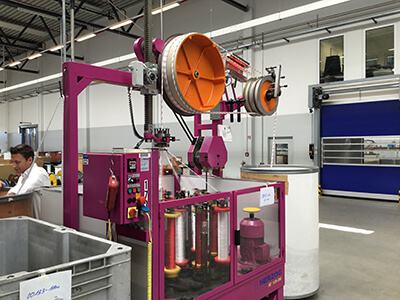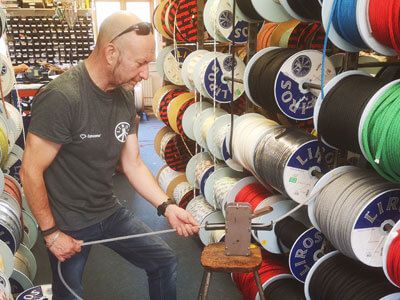Rope Measurement Information
Rope Diameter
Rope is manufactured on complex spinning and weaving machinery.
The amount of yarn per metre is accurately calculated and strictly controlled to produce a finished rope with the correct interacting tension (or lay) at a nominal diameter, normally in 2mm increments in even numbers e.g. 8mm, 10mm, 12mm
1mm increments are also available in some ropes e.g. 7mm, 9mm
Importantly, the final break load of the rope for any given diameter is dependent on the quantity/weight of yarn per metre in the designated construction.
Rope manufacturers publish minimum (or average) break loads for their ropes and therefore all rope production is designed to achieve this rather than concentrating solely on the finished diameter.
When you receive your new rope, it will be in a 'relaxed' state, and consequently may look slightly 'fatter' than the given diameter.
Attempting to measure the diameter of a new rope - by eye, with a tape measure or even callipers - before it has stretched out to a working diameter isn't likely to produce an accurate result.
The true diameter will be more apparent if you hold the rope firmly with one hand, take a firm grip with the other hand and run the rope through your grip without releasing the pressure - a leather glove will protect your hand if required.
Once you have used your new rope, and applied a light load, the interacting weave or lay will elongate to the manufacturer designed structure i.e. it will naturally become slightly thinner and consequently slightly longer. The effect varies across all ropes due to the complex variation of two factors: the construction of the rope and the elasticity of the fibre. This should result in your rope measuring more closely to the nominal diameter.
N.B. The majority of feedback regarding new rope diameter is that the rope is too large.
The most common causes for this are:
- customers erring on the upside when ordering
- measurement before use
- relaxation of the rope construction
Of course, there is the possibility that we may have sent you the wrong rope, but it is extremely rare.
Rope Cut to Length
Rope Structure
Rope manufacturers wind rope onto reels under a degree of tension for two reasons:
- to produce a very neat presentable finish.
- to deliver the rope in the ropemaker's designed structural state
When the rope is pulled off the reel and left in a heap on the floor (or in your parcel) it naturally 'relaxes' i.e. it gets fatter and shorter.
The stretchier the rope, the more it will 'relax'.
The amount that it relaxes also depends on the construction of the rope - a closer, tighter weave is generally less affected e.g. 32 plait and conversely, a looser construction will be more affected e.g. 3 strand and 8 strand
You can demonstrate this to yourself by holding a rope in two hands a short distance apart and pushing them together to exaggerate the 'relaxation'.
The lower the number of plaits or strands, the more the rope will concertina resulting in a looser, fatter and shorter composition.
N.B. There will be no harm done if you run it back through your hand to restore it to the design state after the test.
Jimmy Green Marine began selling rope in 1981, over 40 years ago, and very quickly realised that customers wouldn't always appreciate the finer points of rope construction.
We therefore allow for the concertina effect when measuring your order by adding an appropriate percentage according to the elasticity of the rope i.e. the stretchier it is, the more we add on to compensate.
It is also important to note that once you use your rope under load, the plaits or strands will bed in, and over time, retain their design structure.
N.B. Even clearance ends that have been accurately measured and had the appropriate percentage reduction applied may still arrive in a further relaxed state.

Our Rope Measuring Process
Rope is generally cut to length for your orders by pulling it through a rope measurement meter.
The meter is regularly checked against the true length to ensure that it is reading accurately.
For short, precise dimensions or where the metre method is inappropriate, the rope is pulled out straight in the wire rigging measurement trough.
The Jimmy Green Rigging Team take extra care to ensure that all spliced/finished lengths are accurate e.g. short strops or bridles, and generous for e.g. halyards or sheets.
Rope Measurement Check
If you feel the need to check the length of your rope, please make off one end, hold the rope at that point in your hand and walk away, running the rope through your hand as you go.
A sailing glove or a leather gardening glove is a good protective layer.
This simple action is not scientific. The firmness of your grip and how hard you pull will clearly affect the end result.
However, it will go some way to offset the 'relaxation' and re-establish the manufacturer intended design structure of the rope.
Laying it loosely on the floor to measure a few metres, turning it on the floor and laying it down again repeatedly is likely to lead you to the disappointing conclusion that it is short.
Of course, we are human and there is the possibility that we may have measured the rope incorrectly by mistake, but it is extremely rare.
If you have any issues with your rope purchase, please email sales@jimmygreen.co.uk or ring 01297 20744 and speak to one of our Rigging Sales Team for futher advice or information.














